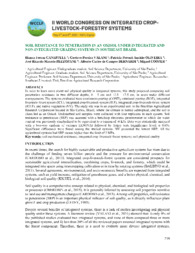Soil resistance to penetration in an oxisol under integrated and non-integrated grazing systems in southeast Brazil.
Soil resistance to penetration in an oxisol under integrated and non-integrated grazing systems in southeast Brazil.
Author(s): CANEPPELE, B. F.; VALANI, G. P.; OLIVEIRA, P. P. A.; PEZZOPANE, J. R. M.; BERNARDI, A. C. de C.; COOPER, M.
Summary: In order to learn more about soil physical quality in integrated systems, this study proposed comparing soil penetration resistance in two different depths, 0 - 5 cm and 12.5 - 17.5 cm, in areas under different managements. The systems evaluated were continuous grazing (CONT), rotational grazing (ROT), integrate livestock-forest system (ICL), integrated crop-livestock system (ILF), integrated crop-livestock-forest system (ICLF), and native vegetation (NV). The study site was in an experimental unit in the Brazilian Agricultural Research Corporation located in São Carlos, Brazil, where the climate is humid subtropical, and the soil is classified as an Oxisol. Undisturbed soil samples were collected with four replicates in each system. Soil resistance to penetration (SRP) was assessed with a benchtop electronic penetrometer in which the water content was previously standardized to be equivalent to a tension of -6 kPa. Data were statistically analyzed with a two-way analysis of variance (ANOVA) followed by Tukey tests (significance level: α=0.05). Significant differences were found among the studied systems. NV presented the lowest SRP. All the agricultural systems had SRP means higher than the limit of 2 MPa.
Publication year: 2021
Types of publication: Paper in annals and proceedings
Observation
Some of Embrapa's publications are published as ePub files. To read them, use or download one of the following free software options to your computer or mobile device. Android: Google Play Books; IOS: iBooks; Windows and Linux: Calibre.
Access other publications
Access the Agricultural Research Database (BDPA) to consult Embrapa's full library collection and records.
Visit Embrapa Bookstore to purchase books and other publications sold by Embrapa.

